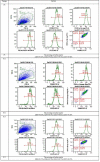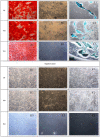Proliferation, Characterization and Differentiation Potency of Adipose Tissue-Derived Mesenchymal Stem Cells (AT-MSCs) Cultured in Fresh Frozen and non-Fresh Frozen Plasma
- PMID: 32587838
- PMCID: PMC7305462
- DOI: 10.22088/IJMCM.BUMS.8.4.283
Proliferation, Characterization and Differentiation Potency of Adipose Tissue-Derived Mesenchymal Stem Cells (AT-MSCs) Cultured in Fresh Frozen and non-Fresh Frozen Plasma
Abstract
Mesenchymal stem cells (MSCs) have unique properties, including high proliferation rates, self-renewal, and multilineage differentiation ability. Their characteristics are affected by increasing age and microenvironment. This research is aimed to determine the proliferation, characteristics and differentiation capacity of adipose tissue-derived (AT)-MSCs at many passages with different media. The cell proliferation capacity was assayed using trypan blue. MSCs characterization (CD90, CD44, CD105, CD73, CD11b, CD19, CD34, CD45, and HLA-DR) was performed by flow cytometry, and cell differentiation was determined by specific stainings. Population doubling time (PDT) of AT-MSCs treated with fresh frozen plasma (FFP) and non-FFP increased in the late passage (P) (P15 FFP was 22.67 ± 7.01 days and non-FFP was 19.65 ± 2.27 days). Cumulative cell number was significantly different between FFP and non-FFP at P5, 10, 15. AT-MSCs at P4-15 were positive for CD90, CD44, CD105, and CD73, and negative for CD11b, CD19, CD34, CD45, and HLA-DR surface markers. AT-MSCs at P5, 10, 15 had potential toward adipogenic, chondrogenic, and osteogenic differentiation. Therefore, PDT was affected by increased age but no difference was observed in morphology, surface markers and differentiation capacity among passages. Cumulative cell number in FFP was higher in comparison with non-FFP in P5, 10, 15. Our data suggest that FFP may replace FBS for culturing MSCs.
Keywords: Adipose tissue-MSCs; multilineage differentiation; population doubling time; proliferation; surface marker.
Figures




Similar articles
-
Extensive characterization of feline intra-abdominal adipose-derived mesenchymal stem cells.J Vet Sci. 2017 Sep 30;18(3):299-306. doi: 10.4142/jvs.2017.18.3.299. J Vet Sci. 2017. PMID: 27456770 Free PMC article.
-
Differentiation Potential of Early- and Late-Passage Adipose-Derived Mesenchymal Stem Cells Cultured under Hypoxia and Normoxia.Stem Cells Int. 2020 Sep 18;2020:8898221. doi: 10.1155/2020/8898221. eCollection 2020. Stem Cells Int. 2020. PMID: 33014073 Free PMC article.
-
Foot fat pad: Characterization by mesenchymal stromal cells in rats.Anat Rec (Hoboken). 2021 Jul;304(7):1582-1591. doi: 10.1002/ar.24549. Epub 2020 Nov 3. Anat Rec (Hoboken). 2021. PMID: 33099882
-
Epithelial In vitro Differentiation of Mesenchymal Stem Cells.Curr Stem Cell Res Ther. 2018;13(6):409-422. doi: 10.2174/1574888X13666180501120416. Curr Stem Cell Res Ther. 2018. PMID: 29714147 Review.
-
Human mesenchymal stem cells - current trends and future prospective.Biosci Rep. 2015 Apr 28;35(2):e00191. doi: 10.1042/BSR20150025. Biosci Rep. 2015. PMID: 25797907 Free PMC article. Review.
Cited by
-
hWJMSCs inhibit inflammation and apoptosis in an ARDS cell model.J Taibah Univ Med Sci. 2023 Jul 7;18(6):1519-1526. doi: 10.1016/j.jtumed.2023.06.007. eCollection 2023 Dec. J Taibah Univ Med Sci. 2023. PMID: 37693823 Free PMC article.
-
Adipose Tissue and Umbilical Cord Tissue: Potential Sources of Mesenchymal Stem Cells for Liver Fibrosis Treatment.J Clin Exp Hepatol. 2024 Jul-Aug;14(4):101364. doi: 10.1016/j.jceh.2024.101364. Epub 2024 Feb 12. J Clin Exp Hepatol. 2024. PMID: 38449506 Free PMC article.
-
Production of Inflammatory Mediators in Conditioned Medium of Adipose Tissue-Derived Mesenchymal Stem Cells (ATMSC)-Treated Fresh Frozen Plasma.Med Sci Monit Basic Res. 2022 Mar 23;28:e933726. doi: 10.12659/MSMBR.933726. Med Sci Monit Basic Res. 2022. PMID: 35318298 Free PMC article.
-
The effect of mesenchymal stem cell-conditioned medium gel on burn wound healing in rat.Vet World. 2022 Apr;15(4):841-847. doi: 10.14202/vetworld.2022.841-847. Epub 2022 Apr 7. Vet World. 2022. PMID: 35698516 Free PMC article.
-
Mesenchymal stromal cell therapy for coronavirus disease 2019: which? when? and how much?Cytotherapy. 2021 Oct;23(10):861-873. doi: 10.1016/j.jcyt.2021.04.004. Epub 2021 Apr 30. Cytotherapy. 2021. PMID: 34053857 Free PMC article. Review.
References
-
- Widowati W, Wijaya L, Murti H, et al. Conditioned medium from normoxia (WJMSCs-norCM) and hypoxia-treated WJMSCs (WJMSCs-hypoCM) in inhibiting cancer cell proliferation. Biomarkers Genomic Med. 2015;7:8–17.
-
- Widowati W, Murti H, Jasaputra DK, et al. Selective cytotoxic potential of IFN-γ and TNF-α on breast cancer cell lines (T47D and MCF7) Asian J Cell Biol. 2016;11:1–12.
-
- Widowati W, Wijaya L, Bachtiar I, et al. Effect of oxygen tension on proliferation and characteristics of Wharton's jelly-derived mesenchymal stem cells. Biomarkers Genomic Med. 2014;6:43–8.
-
- Widowati W, Krisanti Jasaputra D, B Sumitro S, et al. Potential of Unengineered and Engineered Wharton’s Jelly Mesenchymal Stem Cells as Cancer Inhibitor Agent. Immun Endor Metab Agents in Med Chem. 2015;15:128–37.
LinkOut - more resources
Full Text Sources
Research Materials
Miscellaneous
